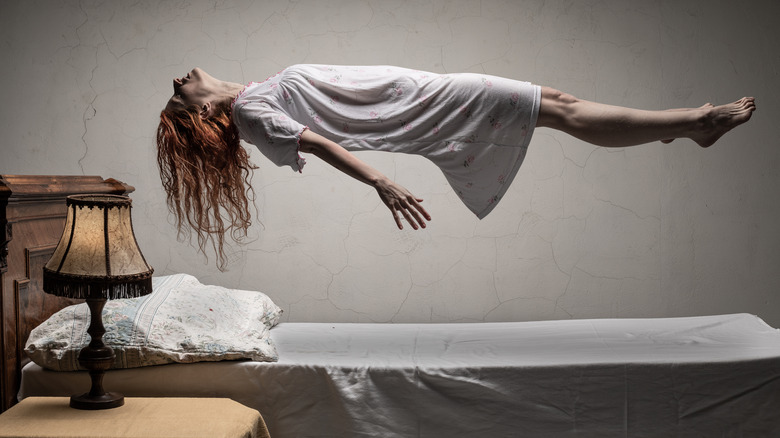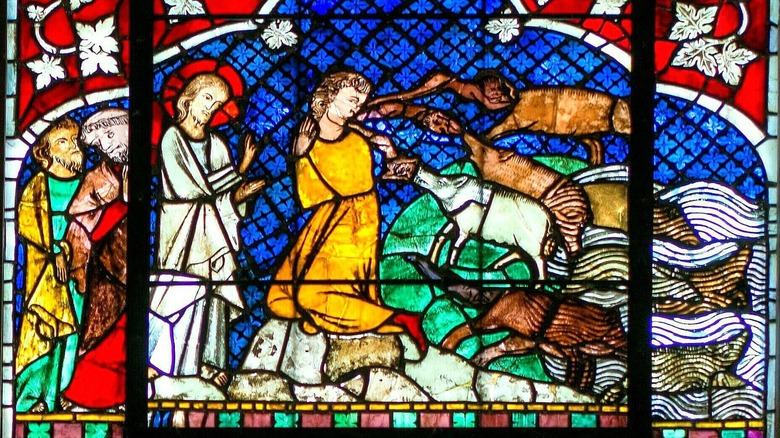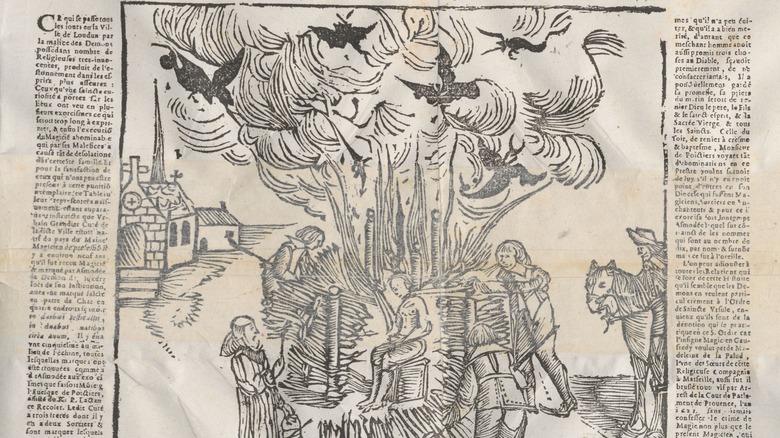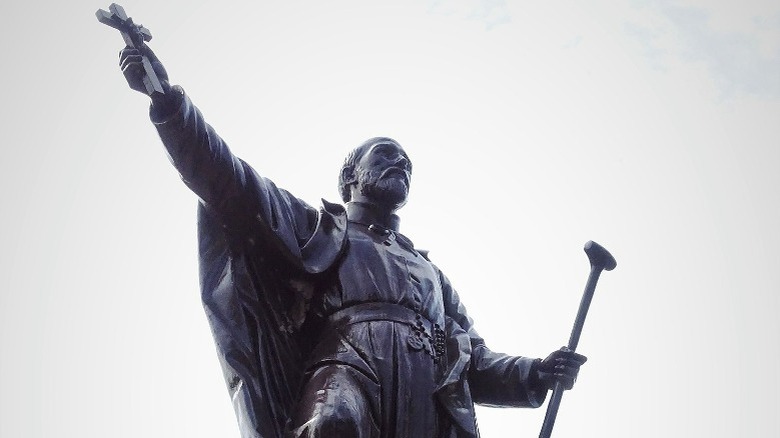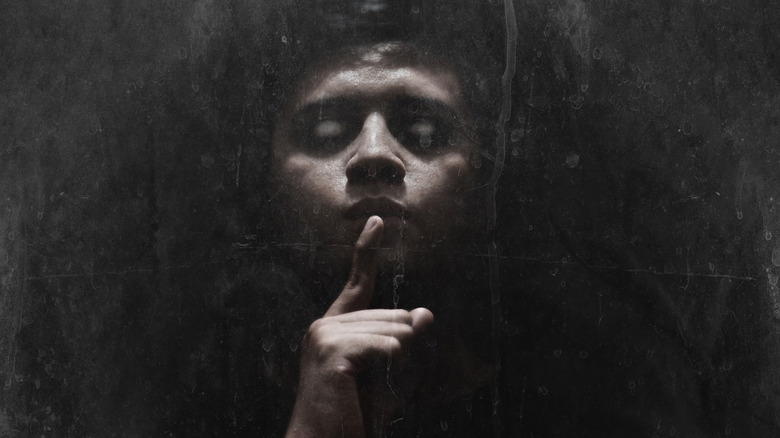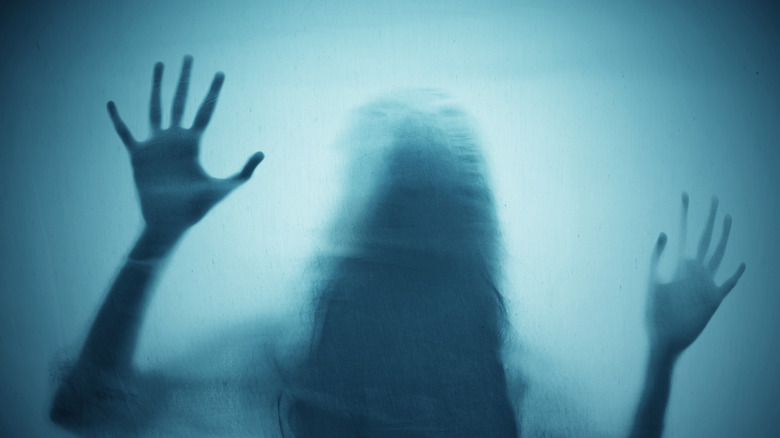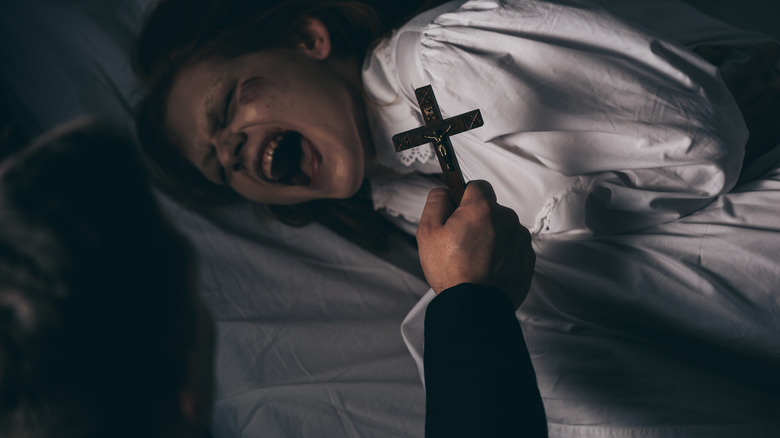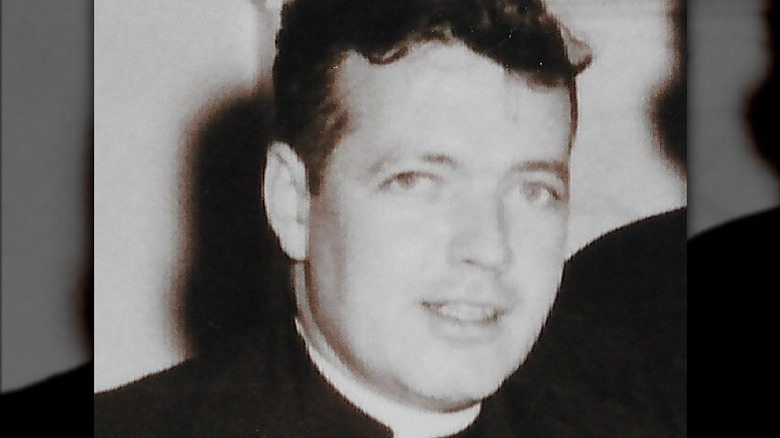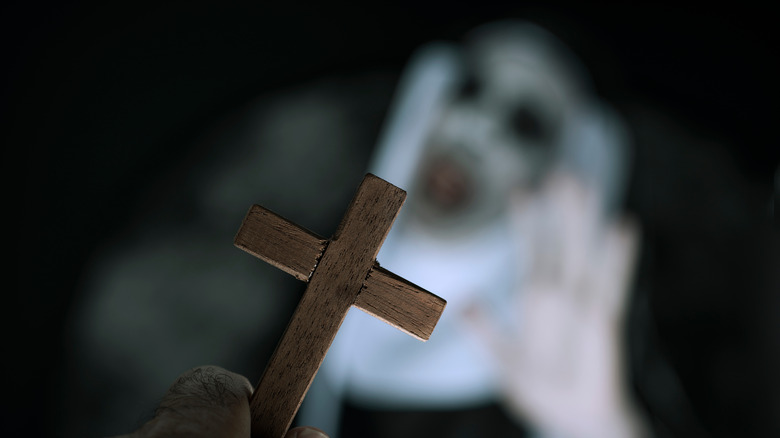The Most Famous And Horrific Exorcisms In History
Any horror movie fan has come across an exorcism or two. Even if you're a bit squeamish about the genre, you've probably absorbed the general image of an exorcist: solemn priest, black coat, book of prayers clutched in one hand as they face of against a head-rotating, pea soup-spewing demon inhabiting the body of some innocent child. But it's not real. Right?
Maybe. Or, maybe not. Depending on who you ask, the problem of demonic possession and the need to exorcise evil spirits is very, very real. Even skeptics are often ready to admit that people involved in these affairs genuinely believe in what's going on, though nonbelievers may point to more mundane explanations like mental illness. The concept is central to the human experience, if the millennia of exorcism tales mean anything. That's no exaggeration, by the way — even the ancient Mesopotamians believed that evil spirits sometimes needed to be shooed out of a living person. Since then, this rite has become a feature of many cultures and religions across the globe. Over all that time and space, some of the most famous tales of exorcisms have become notorious for their bone-chilling and downright horrific circumstances. Here's what has made them stand out from the rest.
If you or someone you know needs help with mental health, please contact the Crisis Text Line by texting HOME to 741741, call the National Alliance on Mental Illness helpline at 1-800-950-NAMI (6264), or visit the National Institute of Mental Health website.
Jesus cast out demons in a graveyard
While it's clear that exorcisms were going on centuries before Jesus came around, the demon-busting he does in the New Testament has proven to be foundational. In Matthew 8:28-34, he has a hair-raising encounter with two men who aren't just possessed but are also inhabiting tombs and attacking passers-by. But the devils don't directly fight Jesus, instead pleading with him to let them take up in a herd of nearby pigs. He lets them do just that, upon which the demons cause the whole group of swine to throw themselves into the ocean. The swineherders hightail it out of there to tell everyone what they just saw, causing a crowd to come to meet Jesus ... and then ask him to leave.
Mark 5:1-17 retells a very similar story, only with even more chilling detail. This time, it's just one possessed man living amongst the graves, though he seemingly manages to approach Jesus on his own. When Jesus asks the spirit's name, it replies in a phrase that may be familiar to horror fans: "My name is Legion: for we are many."
It's not just modern readers or townsfolk who were unnerved by Jesus' exorcisms. In Matthew 12:24-32, the Pharisees claim that this upstart religious leader isn't casting out demons. Instead, he's so good at it that he must be in league with them. Jesus stamps that idea out pretty quickly, but it's clear that word of his exorcist activity had raised hackles.
Nuns claimed possession in Loudun, France
It sounds too much like a horror movie to be real. But a bunch of Ursuline nuns in 1630s France really did have a supposed run-in with the infernal. The trouble began in 1632, per a contemporary account reprinted in "The Penguin Book of Exorcisms." That's when hotshot priest Urbain Grandier rolled into the French town of Loudun. People either went wild for the intelligent, compelling, very un-celibate Grandier, or they hated him. When some of the local nuns began experiencing supposedly demonic activity in September 1632, and when some began working Grandier into their visions, the priest's enemies saw an opening.
The nuns reportedly levitated, spoke in languages the possessed shouldn't know, and contorted themselves into uncomfortable positions. Soon, their exorcisms became public spectacles, which proved to be a convenient platform to publicly condemn Grandier. Eventually, he was arrested, tortured, and burned at the stake in August 1634. During his trial, prosecutors presented a pact that had supposedly been made between the priest and which bore the signatures of several big-name demons, including the Devil himself.
Though some believed that the nuns were possessed, others were far more skeptical. Perhaps the isolated, cloistered nuns were bored. After the initial excitement, the situation could have quickly spiraled out of control. Others pointed to old-fashioned medical explanations that blamed the nuns' biology for inducing hysteria. Mother superior Jeanne de Anges even stood to benefit, as she later traveled around France as a mystic and healer.
One Canadian exorcism used a priest in a shocking way
Barbe Hallay had already experienced demon troubles numerous times in her young life. Per Spiritus: A Journal of Christian Spirituality, Hallay was a servant in the household of Marie Regnouard, a local major landowner in what's now Quebec. Starting around 1660, she exhibited the symptoms of possession. Priests had attempted to banish the devils, but with little success. Always, the demons would return and the girl would recommence her thrashing, eerie speech, and chilling hallucinations.
As historian Mairi Cowan told the CBC, a local man named Daniel Vuil was targeted as a witch who had masterminded Hallay's torment. He was executed, but the girl's episodes continued.
One evening in October 1662, Regnouard had enough. When Hallay began exhibiting the symptoms of possession again, the older woman made her way into the servant's room. But she wasn't going in unarmed. Regnouard carried a relic that she hoped would get rid of whatever was plaguing Hallay — a human rib bone. It had once belonged to Jean de Brébeuf, a Jesuit priest who had been killed in 1649 (pictured). When Regnouard laid the rib on Hallay and began questioning the demon, it eventually escaped the girl's mouth and she was believed to be free. The incident was made all the more remarkable not just because Regnouard had procured a bit of priest in the wilds of colonial Canada, but because she had performed a successful exorcism as a layperson and a woman.
Several people were exorcised in colonial New Mexico
If you have a baby, you must manage the myriad physical changes of pregnancy and birth, as well as any number of emotional effects. Now, imagine having to fight off demons while you're at it. If you had asked Friar Juan José Toledo, that's what happened to one of his parishioners in 1764 Abiquiu, New Mexico. As Friar Toledo explained in a letter to a superior, the unfortunate was María Trujillo, an indigenous woman who kept fainting during mass — during the prayer of exorcism.
It seemed handled until Trujillo gave birth. Mother and baby were physically fine, but a few days later María began experiencing headaches, gastrointestinal trouble, and depression. The fainting came back and was accompanied by rage. By December 18, more than a month after the birth, Friar Toledo resorted to exorcising her. Then another woman, Francisca Barela, began exhibiting similar symptoms. Her spirit wanted to enter María's husband in order to kill her. Between their screams and eerie chants, both Francisca and María began naming evil witches who afflicted them. Soon enough, other women joined them in their affliction, which included lobbing vulgar insults at the friar.
Today, we might guess that María Trujillo had postpartum depression, which can start during pregnancy, per the Mayo Clinic. Moreover, the women may have bristled at the rule of Spanish colonizers. The excuse of possession may have given them a quasi-safe outlet to express their frustrations.
George Lukins was notorious for his possession
Though some may have thought that the Enlightenment that swept through 17th and 18th century Europe would have dusted away all the old world's demons, things weren't so simple. Some maintained that the Devil was alive and well in the new era.
The case of George Lukins, also known more colorfully as the "Yatton Daemoniac," all began around 1770. In a letter that was reportedly "written by a clergyman of undoubted veracity," young George's troubles were said to have started during Christmas festivities. While out with friends, he abruptly fainted. When Lukins came to, he said that he thought he'd been hit by someone who was doling out punishment for Lukins' part in holiday carousing. Thereafter, he was plagued by violent convulsions, fits of singing, the desire to insult bystanders, and singing hymns in reverse. Of course, even the mention of God or church was said to be enough to agitate the possessed Lukins into a frightful state.
This went on for about 18 years, though Lukins managed to become a tailor while being hounded by demons. In 1788, he was subject to an exorcism conducted by Anglican and Methodist ministers, which seemed to do the trick after one last dramatic episode of convulsions and demonic voices. Yet, while the tale of the Yatton Daemoniac spread, many readers were not quite so believing. Some said that Lukins was afflicted by epilepsy, while others concluded that he was merely a fraud.
Clara Germana Tele was said to be frighteningly strong
Clara Germana Tele, was a Zulu girl who attended a Catholic school in 1906 Natal, South Africa, per an account reprinted in "The Penguin Book of Exorcisms." In August 1906, she displayed her first symptoms of what priests took to be demonic possession: levitation, walking on walls, and speaking foreign languages. She was also said to be surprisingly strong and could stretch her neck, arms, and legs to inhuman degrees.
By September, a priest named Father Erasmus turned to exorcism. When he began the ritual, Clara began to rage, striking against the girls and nuns holding her down. Through great effort, the exorcism was concluded and seemed to work. That is, until January 1907, when the girl said that the demons would return. By April, priests held a second exorcism, which included not only Tele, but another girl who had been caught up in the fracas, Monica Mohletsche. One priest at the second exorcism, Bishop Delalle, claimed that the howling Monica was host to seven demons that lent a strange and unnerving look to the girl's eyes.
As for why Clara in particular seemed so susceptible to demonic influence, priests seemed ready to blame all manner of things. Some accounts maintain that she handed a priest a message saying she'd pledged herself to the Devil. Others blamed her parents' non-Christian beliefs, the girl's tumultuous household, or even hinted at sexual abuse within her family as the cause of her possession.
An unnamed woman survived a 23-day exorcism in Iowa
In a 1936 issue of TIME magazine, a hair-raising article appeared that related the story of a dramatic exorcism held in Earling, Iowa. An unnamed middle-aged woman had been suffering from possession for many years. When doctors came up with a collective shrug, the local bishop gave the go-ahead for an exorcism. The woman was escorted to a convent, where seasoned exorcist Father Theophilus conducted the rite.
The woman broke away, flew through the air, and ended high up on a wall. After she was pulled down, the woman claimed to be possessed by not just demons, but also her abusive dead father. When she sensed that holy objects were near, the woman screamed and claimed that she was burning. She also suffered physical effects, said to include a body that seemed to grow large and then deflate, as well unspecified but still presumably disgusting bodily effluvia. Finally, after 23 days, it was all over and the woman seemed to be her own person again.
But who was she? While TIME was coy about naming her, a variety of other accounts deemed her Emma Schmidt, Anna Ecklund, or Mary X. They also claim that the demons came back after the Earling exorcism, that the woman also spoke to heavenly beings, and that the demon-fighting affair would play a part in a larger, grander fight between good and evil that would come sometime after the apocalypse kicked off around 1955.
Roland Doe's exorcism had far-reaching effects
According to St. Louis University, whose priests conducted this dramatic exorcism, the troubles of the teen known as "Roland Doe" started in January 1949, when he first heard scratching noises from inside his room's walls and floor, while objects nearby moved on their own. The activity intensified until one Lutheran minister told them to find a Catholic priest. That priest eventually asked his archbishop for permission to finally hold an exorcism. According to the family and Father Edward Hughes (pictured), the boy was not just screaming and flailing but was also being physically attacked and bore scratches to prove it. When one set of scratches spelled out "Louis," they took it as a sign to travel to his mother's hometown of St. Louis, Missouri.
Once priests in St. Louis began the exorcism, it took nearly a month of nighttime rites to banish whatever possessed the boy. Though he exhibited quite a few violent hallmarks of possession, including what seemed like seizures and even breaking a priest's nose, the boy never appeared to remember what happened the next day. Yet, by mid-April, he was seemingly clear of the force, whether it was ultimately demonic or mental. According to priests, he went on to marry and lead a normal, devil-free life. An August 1949 article published in The Washington Post retold the story, which later inspired author William Peter Blatty to write "The Exorcist." The book was adapted into the classic 1973 horror film of the same name.
Anneliese Michel's exorcism ended in tragedy
Perhaps the most infamous case of deadly exorcism is that of Anneliese Michel, a 23-year-old German woman who died in 1976 after 67 exorcisms, according to The Washington Post. Raised in a conservative Catholic family, Michel was highly religious and often said that she had to suffer in order to atone for the sins of others. She also suffered from epilepsy and had been treated by doctors for the condition. Anneliese and her family also sought a religious explanation for her hallucinations of demonic faces and disembodied voices. After her behavior grew to include barking, disrobing, and eating hair-raising things like spiders and her own excretions, the Michels concluded that she was possessed.
The two priests who conducted the exorcisms recorded a majority of the sessions. On the tapes, Michel made animalistic noises and spoke in eerie voices that presented themselves as a bevy of demons and evil historical figures, including Judas Iscariot, Adolf Hitler, and Lucifer. As the sessions continued, Michel stopped eating and seeing any doctors. She died of starvation, weighing a shocking 68 pounds at her death.
The affair did not end with the young woman's demise. German courts went after both the priests and Michel's parents, finding both guilty of negligent homicide, though they all served minimal sentences. Decades later, Anneleise's mother, Anna, told The Telegraph that she still believed that her daughter had been possessed by demons and that an exorcism was necessary to save the girl's soul.
A 1991 exorcism was televised
If you ask nearly anyone in the hierarchy of the Catholic church, they will likely tell you that there's a good reason exorcisms aren't televised. Taking a long-entrenched holy rite and throwing it up on a screen for the public to consume in lurid fashion isn't exactly respectful to the whole affair. Neither is it generally considered acceptable to take a person who is suffering, either from the symptoms of a mental illness or an infestation of demons, and put their pain on display for entertainment. Yet, it's clear that not everyone agrees on this front, as evidenced by a 1991 exorcism of a teen girl that was broadcast on ABC's "20/20."
According to Newsweek, the girl was pseudonymously known as "Gina." Her exorcism was conducted by two likewise unidentified priests, who had her tied to a chair where she thrashed and snarled nonsense words. Gina's mother had reportedly been led to believe that exorcism was the next step after more medically-approved psychiatric treatment didn't alleviate her daughter's disturbed mental state. But though the priests involved believed that this sort of spiritual infestation needed to be shown to the masses, others wondered if the slickly-produced episode was exploitative. There were rumors that Gina's immigrant mother was pressured into participating by church officials, while it was unclear if Gina herself understood that her torment was being broadcast to the nation.
A Romanian nun died after an exorcism went wrong
Though exorcism may be deeply old-fashioned, that doesn't mean the rite isn't performed well into the modern day. And while some exorcisms can seem almost casual — like those performed over the phone, per Reuters — others can become so intensely personal and physical that lives are lost. Such was the tragic case of Romanian Orthodox nun Maricica Irina Cornici, who died in 2005 after an agonizing exorcism.
At first, as CBS News reported, Cornici appeared to be suffering from schizophrenia. As psychiatrist Gheorghe Silvestrovici told the outlet, she first sought help in April 2005 after she began hearing voices. Doctors told her that this was a schizophrenic hallucination, but it was difficult for Cornici to shake the idea that it was actually the Devil telling her that she was full of sin. She was sent to the Holy Trinity convent in Tanacu, with the plan that she would soon be under medical supervision again. She would never return.
The convent's priest, Daniel Petru Corogeanu, quickly moved to exorcise Cornici. He later told a court that she had become violent and had to be restrained, while she also refused food and drink. Where a hospital might introduce a feeding regimen and round-the-clock supervision, Corogeanu and the convent's nuns left Cornici alone and without sustenance. She eventually died, due to dehydration and suffocation from a gag placed on her face. Corogeanu and four nuns were charged and jailed for her death.
